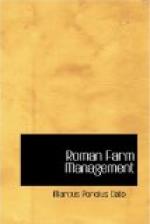By a more exact definition of the seasons, the year is divided into eight parts, the first of forty-five days from the date of the rising of the west wind (February 7) to the date of the vernal equinox (March 24), the second of the ensuing forty-four days to the rising of the Pleiades (May 7), the third of forty-eight days to the summer solstice (June 24), the fourth of twenty-seven days to the rising of the Dog Star (July 21), the fifth of sixty-seven days to the Autumn equinox (September 26), the sixth of thirty-two days to the setting of the Pleiades (October 28), the seventh of fifty-seven days to the winter solstice (December 24), and the eighth of forty-five days to the beginning of the first.[85]
1 deg. February 7-March 24
XXIX. These are the things to be done during the first of the seasons so enumerated: All kinds of nurseries should be set out, the vines should be first pruned, then dug, and the roots which have protruded from the ground should be cut out, the meadows should be cleaned, willows planted and the corn hoed. We call that corn land (seges) which has been ploughed and sowed as distinguished from plough land (arva) which has been ploughed but not yet sowed, while that land which was formerly sowed and lies awaiting a new ploughing is called stubble (novalis). When land is ploughed for the first time it is said to be broken up (proscindere), and at the second ploughing to be broken down (offringere) because at the first ploughing large clods are turned up and at the second ploughing these are reduced. The third cultivation, after the seed has been sown, is called ridging (lirare), that is, when by fastening mould boards on the plough, the sown seed is covered up in ridges[86] and at the same time furrows are cut by means of which the surface water may drain off. Some farmers who cultivate small farms, as in Apulia, are wont to harrow their land after it is ridged, if perchance any large clods have been left in the seed bed. The hollow channel left by the share of the plough is called the furrow, the raised land between two furrows is called the ridge (porca,) because there the seed is as it were laid upon an altar (porricere) to secure a crop, for when the entrails are offered to the gods this word porricere is used to describe the oblation.
2 deg. March 24-May 7
XXX. These are the things to be done during the second season between the vernal equinox and the rising of the Pleiades. Weed the corn land, break up old sod, cut the willows, close the pastures (to the stock) and complete any thing left undone in the preceding season. Plant trees before the buds shoot and they begin to blossom, for deciduous trees are not fit to transplant after they put forth leaves. Plant and prune your olives.
3 deg. May 7-June 24




